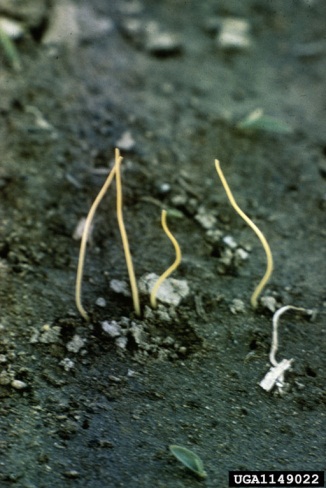Adaptation
The genus Cuscuta is a very studied group because of its adaptations. Some of the most obvious and known adaptations are its parasitic abilities, but adaptations of Cuscuta pentagona start as a seed. Cuscuta can stay dormant for up to sixty years (Cook, 2006), giving it an advantage for successful germination. After germination, only very small roots are put down, and a shoot is formed quickly instead (Sherman, et al. 2008). This allows dodder more time to find a host. Still, Cuscuta has only a few days to locate its host, or it runs out of nutrients (Ombrello).
Cuscuta pentagona has a sense of smell that it uses to find a host. How exactly the smell is detected in Cuscuta is still not pin pointed, but as more research is done to determine more answers will surely be found. To detect a host, the Cuscuta seedling grows, moving in a circular motion called circumnutation (Runyon, et al. 2006). The goal of circumnutation is to allow dodder to come into contact with volatile cues of possible hosts. Volatile cues are chemicals signals a plant naturally emits, or its natural scent so to speak. Cuscuta is able to distinguish between these volatile cues somewhat. For example, Cuscuta pentagona chooses tomatoes over wheat (Runyon, et al. 2006). Dodder isn't all knowing, however. If it attaches to a dead plant or one that can't be a host, Cuscuta dies in a few days (Cook, 2006).
Video from Penn State Live.
If Cuscuta pentagona finds a host, viable or not, it wraps counterclockwise around the stem and it removes its roots from the ground (Cook, 2006). After a few days, if the plant is capable of being a host, a modified root called a haustorium is stuck slowly into the plant's vascular tissue (Ombrello). More about the haustorium and nutrient foraging can be found in Nutrition.
Another adaptation can be seen in the gynoecium of each species. The gynoecium is the female part of the reproductive tissue. Because Cuscuta pentagona lacks vegetative structures, like roots and leaves, the reproductive structures are necessary for morphological classification (McNeal, et al. 2007). Click here for more about Classification. Across the genus Cuscuta there are differences in the gynoeciums. This allows for a subgenus level of grouping. Each subgenus differs slightly. Some have all the same gynocecium structure, while others have slightly unequal, and still others have two different types. The subgenera with unequal or two different types have more species because two different gynoecium types allows for more genetic variation, and later more speciation. The different gynoecium is an adaptation that allows more genetic variation and therefore more success over time. (Wright, 2007).

The style, stigma, ovary, ovules are the female reproductive
structures of the plant. More about these structures can be read in
Reproduction.
